New Challenges
Arguably, no other technical discipline is as sensitive to configuration features as high-angle-of-attack technology. Throughout World War II, the effects of configuration details such as wing airfoil, wing twist,
engine torque, propeller slipstream, and wing placement were critical and, if not properly designed, often resulted in deficient handing qualities accentuated by poor or even vicious stalling behavior. The NACA research staffs at Langley and Ames played key roles in advancing design methodology based on years of accumulated knowledge and lessons learned for straight winged, propeller-driven aircraft. Aberrations of design practice, such as flying wings, had posed new problems such as tumbling, which had also been addressed.[1280] However, just as it appeared that the art and science of designing for high-alpha conditions was under control, a wave of unconventional configuration features emerged in the jet aircraft of the 1950s to challenge designers with new problems. Foremost among these radical features was the use of swept-back and delta wings, long pointed fuselages, and the distribution of mass primarily along the fuselage.
![]() Suddenly, topics such as pitch-up, inertial coupling, and directional divergence became the focus of high-angle-of-attack technology. Responding to an almost complete lack of design experience in these areas, the NACA initiated numerous experimental and theoretical studies. One of the more significant contributions to design methods was the development of a predictive criterion that used readily obtained aerodynamic wind tunnel parameters to predict whether a configuration would exhibit a directional divergence (departure) at high angles of attack.[1281] Typical of many NACA and NASA contributions, the criterion is still used today by designers of high-performance military aircraft.
Suddenly, topics such as pitch-up, inertial coupling, and directional divergence became the focus of high-angle-of-attack technology. Responding to an almost complete lack of design experience in these areas, the NACA initiated numerous experimental and theoretical studies. One of the more significant contributions to design methods was the development of a predictive criterion that used readily obtained aerodynamic wind tunnel parameters to predict whether a configuration would exhibit a directional divergence (departure) at high angles of attack.[1281] Typical of many NACA and NASA contributions, the criterion is still used today by designers of high-performance military aircraft.
As the 1950s progressed, it was becoming obvious that high-alpha maneuverability was becoming a serious challenge. Lateral-directional stability and control were difficult to achieve, and the spin and recovery characteristics of the new breed of fighter aircraft were proving to be extremely marginal. In addition to frequent encounters with unsatisfactory spin recovery, dangerous new posstall motions such as disorienting oscillatory spins and fast flat spins were encountered, which challenged the ability of human pilots to effect recovery.[1282]
 |
|
Automatic flight control systems were designed to limit the maximum obtainable angle of attack to avoid these high-angle-of-attack deficiencies, but severe degradations in maneuver capability were imposed by this approach for some designs. Researchers considered automatic spin recovery concepts, but such systems required special sensors and control components not used in day-to-day operations at that time. Concerns over the cost, maintenance, and the impact of inadvertent actuation of such systems on safety discouraged interest in the development of automatic spin prevention systems.
As the 1950s came to a close, the difficulty of designing for high- angle-of-attack conditions, coupled with the anticipated dominance of emerging air-to-air missile concepts, resulted in a new military perspective on the need for maneuverability. Under this doctrine, maneuverability required for air-to-air engagements would be built into the missile system, and fighter or interceptor aircraft would be designed as standoff missile launchers with no need for maneuverability or high-alpha
capability. Not only did this scenario result in a minimal analysis of high-angle-of-attack behavior for emerging designs, it resulted in a significant decrease in the advocacy and support for NASA research on stall/spin problems. In the late 1950s, Langley was even threatened with a closure of its spin tunnel.[1283]










